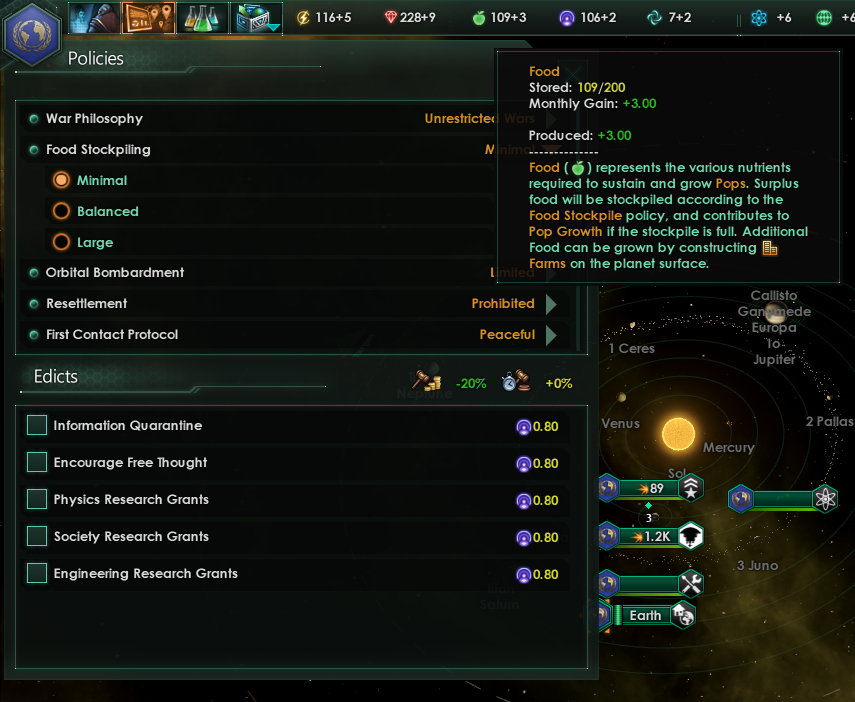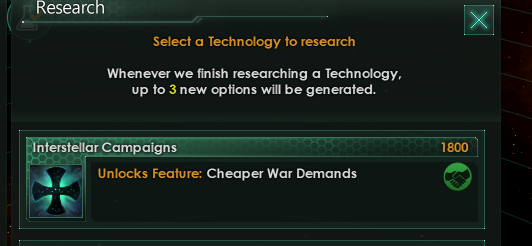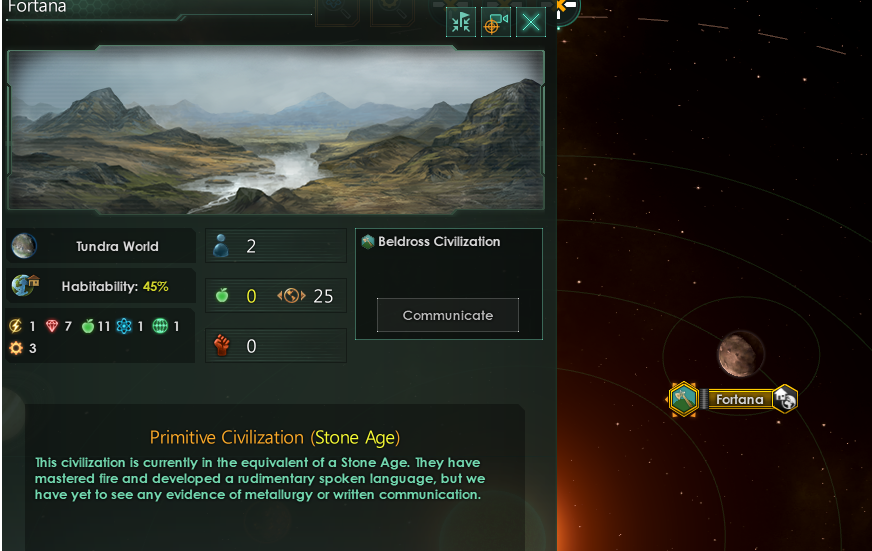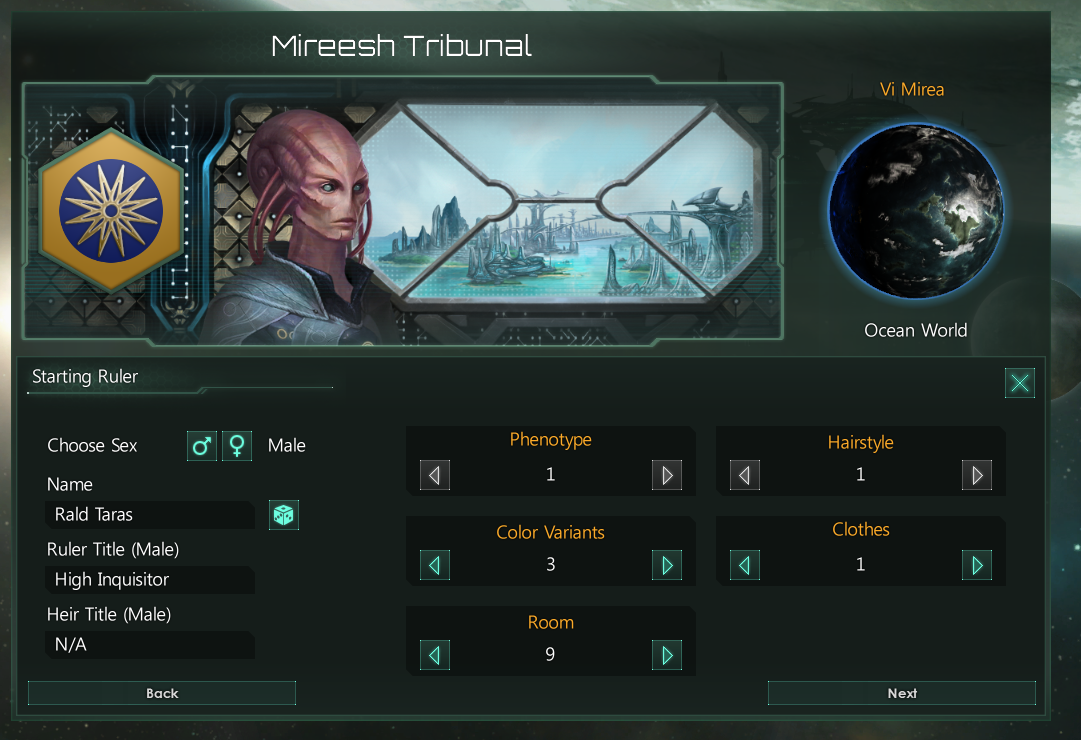Hello everyone and welcome to another Stellaris development diary. Today's dev diary is going to be a bit of a grab bag, as we're going to talk about features in the 1.5 'Banks' update that weren't quite large enough to get their own dev diary, but are still significant enough that we want to highlight them. All features listed in this dev diary are part of the free Banks update rather than the Utopia expansion. There are of course many other minor features, tweaks and fixes in Banks that did not make the cut for this dev diary but will be covered in the full patch notes once we're closer to release.
Empire-wide Food
Probably one of the most hotly requested features since the release of the game, we've changed food in 1.5 so that it is no longer local to planets. Instead, all food produced by planets goes into a 'global' food stockpile, which is used to feed the entire empire. The maximum size of this stockpile depends on your Food Stockpiling policy, and once your food stockpile is full, any additional food produced is instead converted into faster Pop growth across the empire at a rate relative to the size of the population (so an excess of 5 food/month will produce much more growth in a 10 Pop empire than in a 100 Pop empire). Conversely, if the stockpile runs out and food growth is negative, the empire will suffer starvation, halting all Pop growth and applying increasingly severe happiness penalties for all biological Pops.

Terraforming Candidates
As explained in earlier dev diaries, one of the decisions taken early on when it comes to terraforming in Stellaris is to not have every planet be terraformable. This is both for practical reasons (a Stellaris galaxy can contain thousands upon thousands of planets, and having them all be inhabited would be completely unfeasible from a gameplay perspective) and thematic ones, as we want habitable worlds to feel rare and special. However, this means that one of the great staples of sci-fi - terraforming Mars - isn't possible in Stellaris. To resolve this, we've introduced a new type of anomaly called a 'Terraforming Candidate'. Sometimes when surveying Barren worlds, you will find ones that while they do not support life, could theoretically do so if you possess the right technology. Once you have unlocked the Climate Restoration technology, you will be able to terraform these worlds into habitable planets. Mars will always be a Terraforming Candidate, and you will be able to find randomly generated Terraforming Candidates when exploring the rest of the galaxy.

War Demand Costs
A frequent complaint about the mid and late game in Stellaris is that the warscore costs for taking planets simply do not scale well to the size of lategame wars. You can have a gigantic conflict involving dozens or hundreds of planets that results in only a few planets exchanging hands at the end. To address this, we've rebalanced war demands to still be quite expensive in the early game (when conquering a handful of planets is a significant increase in power) but added numerous ways to reduce the cost as the game progresses in the form of traditions and technologies, allowing for vast swathes of territory to change hands in late-game wars.

Stone Age Primitives
Having Stone Age primitives use a system of modifiers and tile blockers always felt a bit odd, owing to the fact that it is a legacy system designed before pre-sentients and later primitive civilizations were given proper Pops. For 1.5, we've reworked Stone Age civilizations to use the same systems as regular primitives, meaning they have Pops, can be studied and conquered using armies.

Picking Room Backgrounds
Another occasionally requested feature has been the ability to pick your own room background when designing your species, instead of having it automatically generated by your ethics. In 1.5, you will be able to select your room background in the Ruler customization screen. We've also added a new room background in a Hive Mind style.

That's all for today! Next week we'll be talking about the new music and sounds coming in Banks and Utopia, as well as showing off the Music Player that will be included with the free update.
Empire-wide Food
Probably one of the most hotly requested features since the release of the game, we've changed food in 1.5 so that it is no longer local to planets. Instead, all food produced by planets goes into a 'global' food stockpile, which is used to feed the entire empire. The maximum size of this stockpile depends on your Food Stockpiling policy, and once your food stockpile is full, any additional food produced is instead converted into faster Pop growth across the empire at a rate relative to the size of the population (so an excess of 5 food/month will produce much more growth in a 10 Pop empire than in a 100 Pop empire). Conversely, if the stockpile runs out and food growth is negative, the empire will suffer starvation, halting all Pop growth and applying increasingly severe happiness penalties for all biological Pops.

Terraforming Candidates
As explained in earlier dev diaries, one of the decisions taken early on when it comes to terraforming in Stellaris is to not have every planet be terraformable. This is both for practical reasons (a Stellaris galaxy can contain thousands upon thousands of planets, and having them all be inhabited would be completely unfeasible from a gameplay perspective) and thematic ones, as we want habitable worlds to feel rare and special. However, this means that one of the great staples of sci-fi - terraforming Mars - isn't possible in Stellaris. To resolve this, we've introduced a new type of anomaly called a 'Terraforming Candidate'. Sometimes when surveying Barren worlds, you will find ones that while they do not support life, could theoretically do so if you possess the right technology. Once you have unlocked the Climate Restoration technology, you will be able to terraform these worlds into habitable planets. Mars will always be a Terraforming Candidate, and you will be able to find randomly generated Terraforming Candidates when exploring the rest of the galaxy.

War Demand Costs
A frequent complaint about the mid and late game in Stellaris is that the warscore costs for taking planets simply do not scale well to the size of lategame wars. You can have a gigantic conflict involving dozens or hundreds of planets that results in only a few planets exchanging hands at the end. To address this, we've rebalanced war demands to still be quite expensive in the early game (when conquering a handful of planets is a significant increase in power) but added numerous ways to reduce the cost as the game progresses in the form of traditions and technologies, allowing for vast swathes of territory to change hands in late-game wars.

Stone Age Primitives
Having Stone Age primitives use a system of modifiers and tile blockers always felt a bit odd, owing to the fact that it is a legacy system designed before pre-sentients and later primitive civilizations were given proper Pops. For 1.5, we've reworked Stone Age civilizations to use the same systems as regular primitives, meaning they have Pops, can be studied and conquered using armies.

Picking Room Backgrounds
Another occasionally requested feature has been the ability to pick your own room background when designing your species, instead of having it automatically generated by your ethics. In 1.5, you will be able to select your room background in the Ruler customization screen. We've also added a new room background in a Hive Mind style.

That's all for today! Next week we'll be talking about the new music and sounds coming in Banks and Utopia, as well as showing off the Music Player that will be included with the free update.

